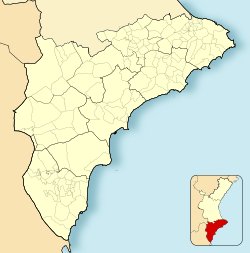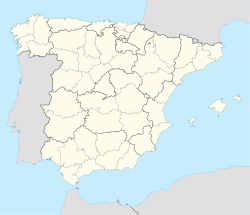Guardamar del Segura (Valencian: [ˌɡwaɾðaˈmaɾ ðel seˈɣuɾa]), or briefly Guardamar, is a municipality of the province of Alicante located at the mouth of the river Segura in southern Valencia (autonomous community), Spain. It is a Mediterranean resort, with a large pine forest abutting an 11-km-long white sand beach.
Guardamar del Segura | |
|---|---|
 Guardamar Town Hall | |
| Coordinates: 38°5′23″N 0°39′18″W / 38.08972°N 0.65500°W | |
| Country | |
| Autonomous community | |
| Province | Alicante |
| Comarca | Baix Segura / Vega Baja |
| Judicial district | Torrevieja |
| Founded | 10th century |
| Government | |
| • Mayor | Carmen Verdú (2011) (PP) |
| Area | |
• Total | 35.58 km2 (13.74 sq mi) |
| Elevation | 25 m (82 ft) |
| Population (2018)[1] | |
• Total | 15,058 |
| • Density | 420/km2 (1,100/sq mi) |
| Demonym(s) | guardamarenc, -a (Val.) guardamarenco, -a (Sp.) |
| Time zone | UTC+1 (CET) |
| • Summer (DST) | UTC+2 (CEST) |
| Postal code | 03140 and 03149 |
| Dialing code | 965 and 966 |
| Official language(s) | |
Historically, it was an area of fishermen and farmers. A Phoenician colony, called Herna by Roman geographer Avienius in his book Ora Maritima was the first settlement near the mouth of Segura river,[2] In Valencian, guardar means safekeeping and mar means sea, and this is another possible basis for its current name.
Guardamar is the southernmost Valencian-speaking town and in 1991 41.8% of the town's residents could speak it.[3] Guardamar is also the only municipality of the Vega Baja del Segura comarca (known locally as Baix Segura) where Valencian is traditionally and widely spoken.
Guardamar hosts local festivals like Moros i Cristians (Moros y Cristianos), L'Encantà, and Fogueres de Sant Joan (Hogueras de San Juan), which commemorate its history.
Population
editThe INE (Spanish Census) of 2006 showed that the city had 14,261 residents. By January 2011 this figure had reached 16,863 of which 10,051 were Spanish. The total dropped by 2015 to 15,589. The most prominent nationalities in 2015 were:
|
|
Government
editCarmen Verdú is the mayor of the city. In the latest municipal elections of May 2011, Carmen Verdú of the People's Party (Partido Popular) won the elections with an absolute majority, larger than the one the former mayor (María Elena Albentosa) had, while the opposition (Socialist Party) lost some of their popular support. She is the second woman ever to occupy this position.
At the 2015 local elections, the political composition on the local council was:
| Party[5] | Seats | |
|---|---|---|
| PP | 8 | |
| PSOE | 7 | |
| IU-Acord Ciutadà | 1 | |
| We Want Guardamar del Segura | 1 | |
Geography
editClimate
edit| Climate data for Guardamar del Segura | |||||||||||||
|---|---|---|---|---|---|---|---|---|---|---|---|---|---|
| Month | Jan | Feb | Mar | Apr | May | Jun | Jul | Aug | Sep | Oct | Nov | Dec | Year |
| Mean daily maximum °C (°F) | 16 (61) |
17 (63) |
19 (66) |
20 (68) |
23 (73) |
27 (81) |
30 (86) |
31 (88) |
28 (82) |
24 (75) |
20 (68) |
17 (63) |
23 (73) |
| Mean daily minimum °C (°F) | 6 (43) |
7 (45) |
8 (46) |
10 (50) |
13 (55) |
16 (61) |
19 (66) |
20 (68) |
18 (64) |
14 (57) |
10 (50) |
7 (45) |
12 (54) |
| Average precipitation mm (inches) | 25 (1.0) |
29 (1.1) |
28 (1.1) |
34 (1.3) |
29 (1.1) |
20 (0.8) |
7 (0.3) |
13 (0.5) |
37 (1.5) |
67 (2.6) |
46 (1.8) |
36 (1.4) |
371 (14.5) |
| Source: holiday-weather.com | |||||||||||||
Points of interests
edit- Torreta de Guardamar, a radio mast. The tallest military structure in the European Union.
References
edit- ^ Municipal Register of Spain 2018. National Statistics Institute.
- ^ Bierling, Marilyn R. and Gitin, Seymour (2002). The Phoenicians in Spain: an archaeological review of the eighth-sixth centuries B.C.E.: a collection of articles translated from Spanish. Eisenbrauns, p. 124. ISBN 1-57506-056-6
- ^ "Fons estadístic documental - Generalitat Valenciana". www.edu.gva.es. Retrieved 20 April 2018.
- ^ from 1857: national census.
- ^ MIR - Guardamar de Segura.
External links
edit- Agrupación Musical de Guardamar del Segura
- guardamardelsegura.com
- Guardamar del Segura Quiz at LetsQuiz




